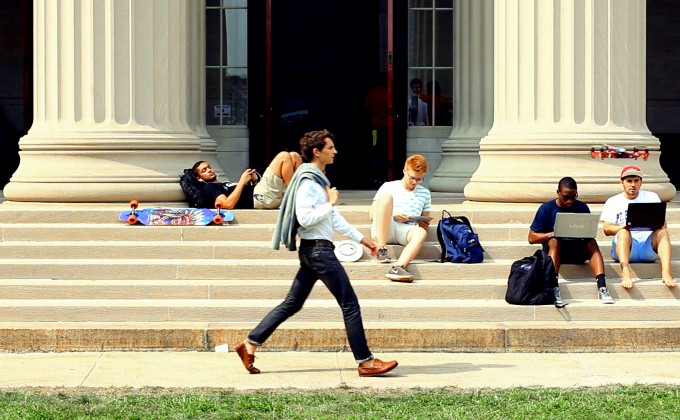Terri Park | MIT Innovation Initiative
February 25, 2016
Using the MIT campus as a case study, Matthew Claudel examines the effect of spatial configuration on communication patterns and scholarly output of the MIT community. His thesis work — part of a research project headed by Carlo Ratti, director of the Senseable City Lab at MIT, and Fiona Murray, the Bill Porter Professor of Entrepreneurship at MIT, associate dean for innovation at MIT Sloan, and co-director of the MIT Innovation Initiative — will map faculty to space to investigate if location and proximity serves as an initiator of collaboration and productivity. More generally, Claudel is interested in exploring whether built environments support a higher instance of cross-disciplinary activity within a community.
“The MIT campus is generating all sorts of fascinating data,” says Claudel. “For example, by looking at Wi-Fi activity on campus, we know how many devices are connected to any particular hot spot at any given time so you can see which areas are the most vibrant and the most well used. Comparing this to collaboration patterns may point to a so-called ‘infinite corridor’ effect — if active spaces promote knowledge sharing.”
Currently pursuing a master’s of science degree in urban studies and planning, Claudel initially joined the MIT community in 2013 as a research fellow with the Senseable City Lab. A research initiative housed within MIT’s Department of Urban Studies and Planning, the Senseable City Lab studies and predicts ways in which digital technology is changing how people describe, design and occupy cities. After presenting his work to a community of students and faculty on campus engaged in innovation science and research, he was invited to serve as the inaugural Innovation Scholar for the MIT Innovation Initiative Laboratory for Science and Policy. The Lab, which builds systematic evidence about how the innovation process works and the factors that affect its rate, direction and trajectory, helps to build community among masters and doctoral students studying the process of innovation, and to foster their abilities to contribute to the emerging field of innovation science. Over time, through findings from thesis work such as Claudel’s, the Lab aims to develop a new approach to innovation research that intersects the study of innovation with its practice, drawing insight from as well as informing the innovation that occurs at MIT.
A native of California, Claudel attended Yale University where he received a bachelor of arts in architecture degree. When asked about his interest in the field, he reflected, “It was not something I had really thought about before university. It wasn’t a career path that was on my radar, but I realized there is this discipline that is academically, philosophically and intellectually rigorous, but at the same time, you’re building, making and designing things.”
Since then, he has built on his background of architecture, shifting his focus to the process of design rather than the act of designing. “To me it’s always been about thinking about the ways in which space is created and the ways in which space impacts on our creative endeavor,” says Claudel. It’s a sentiment that’s inspired much of his work as a designer, researcher, writer and student in numerous ways. Last June, he published a book he co-authored with Ratti entitled “Open Source Architecture.” The book is a visionary manifesto for the field of architecture to embrace a more inclusive, network-driven process in design utilizing modern trends such as crowdsourcing, open access and mass customization.
Claudel’s current research focus on place-based collaboration strongly ties into his interest in the interplay between innovation, entrepreneurship, social change and the built environment. “There’s a reason why we aggregate and join a community such as MIT. It’s not only a relational and social community, but also a spatial community. Particularly in the context of digital communications and the ubiquity of networked technologies, the relevance of physical space is an urgent question.” He continues, “It’s now just as easy for me to collaborate with anyone in the world as it is to collaborate with someone one floor up. And yet, here we are, there’s something about space, and that’s really what I’m looking at.”
Slated to graduate in June 2016, Claudel says he’s still planning his next step, but diving into the startup world may be a potential path. Claudel has been working with Dennis Frenchman, the Leventhal Professor of Urban Design and Planning at MIT and associate dean and chair of the Masters in City Planning program, and others to develop an accelerator for urban innovation housed in the School of Architecture + Planning (SA+P).
According to Claudel, the idea was born out of a critical view of architecture and design as a profession where a traditional paradigm of practice is still present today. “The studio model of design and architecture education is like an idea factory. It’s not unlike an accelerator in and of itself. You have a challenge, you need to come up with a great solution, and you need to articulate it well. And yet, when students graduate, all that work is essentially reduced to a tiny portfolio and never thought of as something that can be pursued as a startup,” says Claudel.
Witnessing a groundswell of change happening in many fields with the introduction of entrepreneurship, Claudel hopes that the accelerator can show aspiring designers there are options beyond the traditional career trajectory of joining a large firm after graduating. “I want to tell people ‘hey, you could actually be an entrepreneur, there are viable pathways for you to launch your own firm,’ which is something that now might never occur to SA+P students, even though they hold all the skills to do it.”


